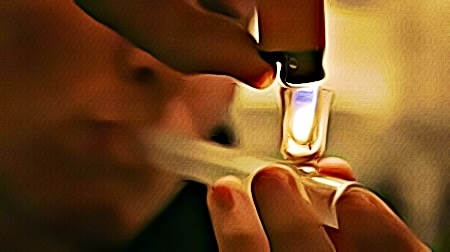When people think of crack or cocaine, they tend to think they are the same thing. In fact, “crack cocaine” is a portmanteau that combines two substances that differ in appearance, preparation, use, and effects on a human body—which is probably why there’s confusion as to the difference between the two drugs.
Crack vs. Cocaine
Cocaine is a powdered stimulant that is extracted from the coca plant found in South America. Meanwhile, crack is cocaine that’s processed with baking soda or ammonia to form a rock. Both are highly addictive drugs that raise energy, attention, and alertness.

In South America, populations have been chewing on coca plant leaves for nearly 5,000 years, but isolated cocaine only arrived in the United States in the late 1800s. For decades, cocaine was placed in tonics, wine, and elixirs for the consumption of people in all classes.
Cocaine was not officially banned until 1922. Today, the United States Drug Enforcement Administration classifies cocaine as a Schedule II drug—something that causes physical or psychological dependence. Physicians can legally administer it for limited procedures, but any recreational use or distribution is a crime.
Crack cocaine emerged in urban areas in the 1970s and gained popularity in the 1980s. It is much less expensive but more addictive and has more potent effects than cocaine. Crack cocaine simply goes by the name of crack on the streets or its drug slang name. Unfortunately, crack use is still widespread in lower-income communities to this day. Like cocaine, crack is a Schedule II drug as well.
Cocaine and crack are chemically identical and produce similar results. However, small differences in appearance and effects prevent them from being interchangeable, especially in the eyes of the law.
Difference in Appearance
What Is Cocaine?
One of the main differences between crack and cocaine is the appearance. Cocaine is a hydrochloride salt in white powder form. When dealers sell cocaine, they usually mix it with baking soda or talcum powder to stretch their product across many buyers.
What Is Crack?
Crack (derived from the crackling sound produced when it is heated) is a solid rock that’s a product of dissolving cocaine in water, mixing in baking soda, and boiling the mixture to leave behind a more concentrated form of cocaine. It can be any shade between white and light brown. When sold, crystal sizes can be between one-tenth to one-half of a gram.

Difference in Ways of Use
Smoking Crack
When smoking crack, individuals use a crack pipe where crack is heated at one end of a glass pipe and inhaled at the opposite end. When inhaled, the smoke should be exhaled immediately. Holding it in will only burn the lungs and will not extend the high.
Cocaine Use
Powder cocaine is famously snorted through the nose, but it can be used in many different ways:
- Ingested
- Dissolved in water
- Rubbed on gums
- Injected directly into the veins
- Smoked via a cigarette or a joint
Cocaine’s effects are felt depending on how it enters the body. For example, the high from nasal entry takes 3 to 5 minutes. Meanwhile, the high from intravenous injections can be felt within 15 to 30 seconds!
How Long Do They Stay in Your System?
How Long Does Cocaine Stay in Your System?
Cocaine’s metabolites can be detected in five ways:
Blood: 12 hours (cocaine), 48 hours (metabolite)
Saliva: 1-2 days
Urine: 2-3 days, or up to 2 weeks for heavy cocaine users
Sweat: A few weeks
Hair: Several months
Drug testing is usually done using urine because of the wider detection window and faster results.
How Long Does Crack Stay in Your System?
Crack has a shorter half-life than cocaine, but it can still be easily detected in the system through several methods:
Blood: 2-12 hours
Saliva: Up to 24 hours
Urine: 1-4 days, up to several weeks
Hair: 3 months, up to several years
Difference in Effects
One of the main differences between crack and cocaine is the kind of high that is produced. The intensities and durations of a high depend on how a drug is administered—through injections, snorted up the nose, or smoked through a pipe.
Cocaine Effects
When cocaine is snorted, it isn’t delivered to the brain all too quickly. The high comes on within 1-5 minutes, peaks within 20-30 minutes, and dissipates within 1-2 hours. When it is injected directly into the bloodstream, the high takes hold within 1 minute, peaks within 3-5 minutes, and dissipates in under an hour.
The unique “cocaine high” or cocaine intoxication is the main reason people use cocaine. A special kind of intense pleasure or euphoria is brought on due to large amounts of dopamine production. There is also the illusion of tremendous self-confidence as well as extreme sociability. This intense joy and excitement are very rewarding—and it is why people want to get high on cocaine over and over again.

If used regularly, cocaine tolerance means higher doses of cocaine are needed to reach the same high. At the same time, sensitization increases—less cocaine is required to induce convulsions and anxiety attacks. Repeated use of cocaine can lead to full-blown psychosis and hallucinations.
Regular snorting of cocaine can lead to a loss of smell, damaged nasal passages, and a chronically inflamed, runny nose. If the injection route is taken, there is a risk of contracting HIV or hepatitis C through dirty needles.
Other cocaine side effects include:
- Increased heart rate, blood pressure, and temperature
- Constricted blood vessels
- Dilated pupils
- Overstimulation and restlessness
- Light and touch sensitivity
- Anxiety and paranoia
- Insomnia
- Decreased appetite
- Organ damage
- Impaired cognitive function
- High potential for relapse
Side Effects of Crack
When crack is smoked, the effect takes hold quickly because the substance enters the bloodstream through the lungs. The high takes hold within 10-15 seconds, peaks in 3-5 minutes, and dissipates in under an hour. The risk of overdosing on crack is much higher because it needs to be inhaled much more often to maintain the high.
The effects of crack vary depending on the purity of the cocaine that’s used to make it. The effects are much more intense than cocaine because it’s a distilled version of the powder. Crack is so potent that addiction can occur even after using it just once.
Smoking crack can cause permanent damage to the lungs. Crack pipes are often very short so that users can inhale more of the smoke. This causes “crack lip,” which are blisters formed from pressing a hot pipe against the lips.
Crack is a powerful stimulant that places the cardiovascular system under immense strain. Even sporadic use can cause blood flow to decrease, leading to a system malfunction. The heart pounds so fast during a high that it can lead to an abnormal heart rhythm.
Crack changes brain function as well. Inhaling stimulates the brain’s reward pathway so frequently that coming down from a high causes deep depression. This exacerbates the developing addiction and physical dependence.

Regular users develop a mental obsession to crack that is difficult to hide because of the difficulty to maintain any other streams of conversation. Stronger, more frequent doses are needed to keep the high going—leading to even more physical, emotional, and psychological damage in the process.
Other crack side effects include:
- Increased heart rate and blood pressure
- Dilated pupils
- Light and touch sensitivity
- Decreased appetite
- Overstimulation
- Irritability and restlessness
- Depression and anxiety
- Organ damage
- Impaired cognitive function
- High potential for relapse
Conclusion
Cocaine and crack share some similarities, but they are not interchangeable due to their differences in appearance, use, and side effects. Both are highly addictive substances that should not be used or distributed. Any form of use will cause physical, psychological, emotional, mental, and even financial damage.




